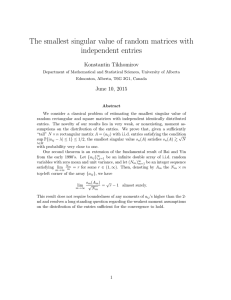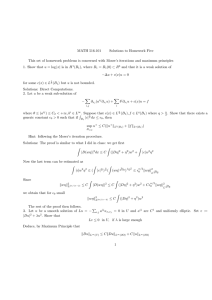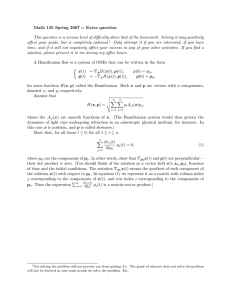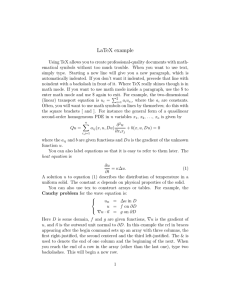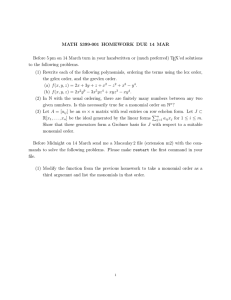A New Condition for Convergence in Continuous-Time Consensus Seeking Systems Please share
advertisement
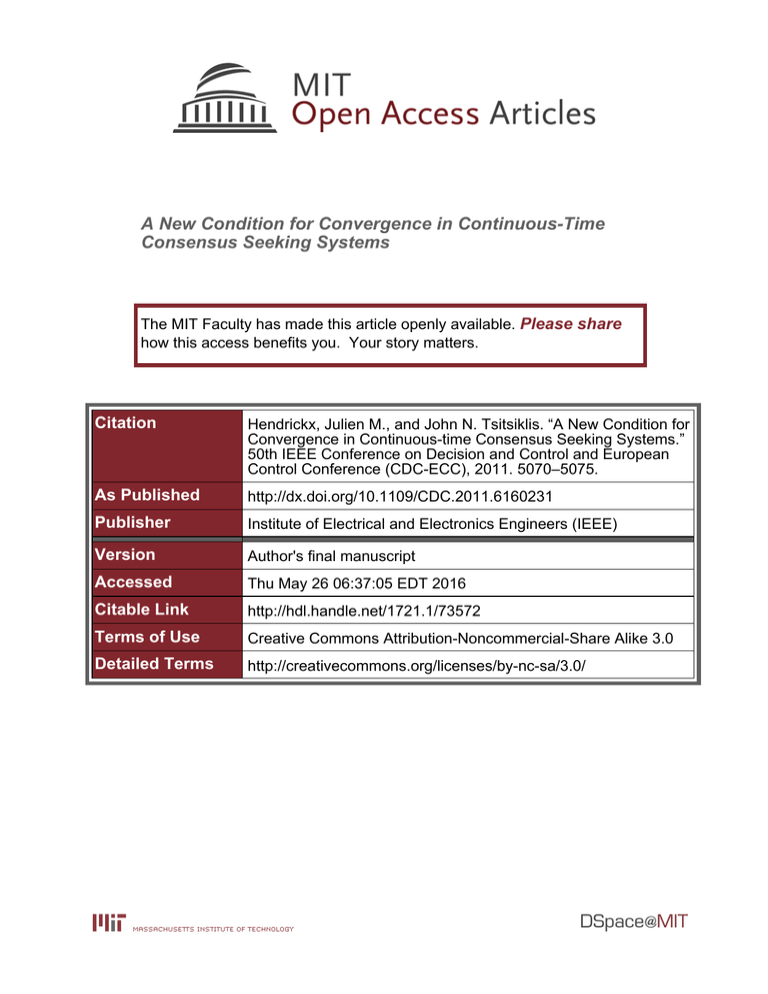
A New Condition for Convergence in Continuous-Time
Consensus Seeking Systems
The MIT Faculty has made this article openly available. Please share
how this access benefits you. Your story matters.
Citation
Hendrickx, Julien M., and John N. Tsitsiklis. “A New Condition for
Convergence in Continuous-time Consensus Seeking Systems.”
50th IEEE Conference on Decision and Control and European
Control Conference (CDC-ECC), 2011. 5070–5075.
As Published
http://dx.doi.org/10.1109/CDC.2011.6160231
Publisher
Institute of Electrical and Electronics Engineers (IEEE)
Version
Author's final manuscript
Accessed
Thu May 26 06:37:05 EDT 2016
Citable Link
http://hdl.handle.net/1721.1/73572
Terms of Use
Creative Commons Attribution-Noncommercial-Share Alike 3.0
Detailed Terms
http://creativecommons.org/licenses/by-nc-sa/3.0/
A new condition for convergence in continuous-time consensus seeking
systems
Julien M. Hendrickx and John N. Tsitsiklis
Abstract— We consider continuous-time consensus seeking
systems whose time-dependent interactions are cut-balanced, in
the following sense: if a group of agents influences the remaining
ones, the former group is also influenced by the remaining ones
by at least a proportional amount. Models involving symmetric
interconnections and models in which a weighted average of the
agent values is conserved are special cases. We present a result
guaranteeing the convergence of every cut-balanced system,
and giving a sufficient condition on the evolving interaction
topology for the limit values of two agents to be the same. This
condition is also necessary up to a zero-measure subset of the
initial conditions. Using the fact that our convergence requires
no additional condition, we show that it also applies to systems
where the agent connectivity and interactions are random, or
endogenous, that is, determined by the agent values. We also
derive corresponding results for discrete-time systems.
I. I NTRODUCTION
We consider continuous-time consensus seeking systems
of the following kind: each of n agents, indexed by i =
1, . . . , n, maintains a value xi (t), which is a continuous function of time and evolves according to the integral equation
version of
n
X
d
xi (t) =
aij (t) (xj (t) − xi (t)) .
(1)
dt
j=1
Throughout we assume that each aij (·) is a nonnegative and
measurable function. We introduce the following assumption
which plays a central role in this paper.
Assumption 1: (Cut-balance) There exists a constant K ≥
1 such that for all t, and any subset S of {1, . . . , n}, we have
X
X
aij (t) ≤ K
aji (t).
(2)
i∈S,j ∈S
/
i∈S,j ∈S
/
Intuitively, if a group of agents influences the remaining
ones, the former group is also influenced by the remaining
ones by at least a proportional amount. This condition may
seem hard to verify in general. But, several important particular classes of consensus-seeking systems automatically
satisfy it. These include symmetric systems (aij (t) = aji (t)),
type-symmetric systems (aij (t) ≤ Kaji (t)), and, as will be
seen later, any system whose dynamics conserve a weighted
average (with positive coefficients) of the agent values.
This research was supported by the National Science Foundation under
grant ECCS-0701623, and by postdoctoral fellowships from the F.R.S.FNRS (Belgian Fund for Scientific Research) and the B.A.E.F. (Belgian
American Education Foundation).
Université catholique de Louvain, B-1348 Louvain-la-Neuve, Belgium;
julien.hendrickx@uclouvain.be. This research was conducted while visiting LIDS, MIT.
Laboratory for Information and Decision Systems, Massachusetts Institute
of Technology, Cambridge, MA 02139, USA; jnt@mit.edu.
We present a result establishing that, under the cut-balance
condition (2), and without any further assumptions, each
value xi converges to a limit. Moreover, xi and xj converge
to the same limit if i and j belong to the same connected
component of the “unbounded interactions graph,” i.e., the
graph
R ∞ whose edges correspond to the pairs (j, i) for which
aij (τ ) dτ is infinite. (As we will show, while this is a
0
directed graph, each of its weakly connected components is
also strongly connected.) Conversely, xi and xj generically
converge to different limits if i and j belong to different connected components of that graph. (This latter
R T result involves
an additional technical assumption that 0 aij (τ ) dτ < ∞
for every T < ∞.)
Motivation for our condition comes from the fact that
there are many systems in which an agent cannot influence
the others without being subjected to at least a fraction
of the reverse influence. This is, for example, a common
assumption in numerous models of social interactions and
opinion dynamics [7], [17] or physical systems.
A. Background
Systems of the form (1) have attracted considerable attention [14], [22], [24], [25], [31] (see [23], [26] for surveys),
with motivation coming from decentralized coordination,
data fusion [5], [32], animal flocking [8], [12], [30], and
models of social behavior [3], [4], [7], [9], [16], [17].
Available results impose some connectivity conditions on
the evolution of the coefficients aij (t), and usually guarantee
exponentially fast convergence of each agent’s value to a
common limit (“consensus”). For example, Olfati-Saber and
Murray [24] consider the system
X
d
xi (t) =
(xj (t) − xi (t))
dt
j:(j,i)∈E(t)
with a time-varying directed graph G(t)
=
({1, . . . , n}, E(t)); this is a special case of the model
(1), with aij (t) equal to one if (j, i) ∈ E(t), and equal
to zero otherwise. They show that if the out-degree of
every node is equal to its in-degree at all times, and if
each graph G(t) is strongly connected, then the system is
average-preserving
and each xi (t) converges exponentially
P
fast to n1 j xj (0). They also obtain similar results
for systems with arbitary but fixed aij . Moreau [21]
establishes exponential convergence to consensus under
weaker conditions: he only assumes that the aij (t) are
uniformly bounded, and that there exist T > 0 and δ > 0
such that the
directed graph obtained by connecting i to j
R t+T
whenever t
aij (τ ) dτ > δ has a rooted spanning tree,
for every t. Several extensions of such results, involving for
example time delays or imperfect communications, are also
available.1
All of the above described results involve conditions
that are easy to describe but difficult to ensure a priori,
especially when the agent interactions are endogenously
determined. This motivates the current work, which aims
at an understanding of the convergence properties of the
dynamical system (1) under minimal conditions. In the
complete absence of any conditions, and especially in the
absence of symmetry, it is well known that consensus seeking
systems can fail to converge; see e.g., Ch. 6 of [1]. On the
other hand, it is also known that more predictable behavior
and positive results are possible in the following two cases:
(i) symmetric (suitably defined) interactions, or (ii) averagepreserving systems (e.g., in discrete-time models that involve
doubly stochastic matrices).
B. Our contribution
Our cut-balance condition subsumes the two cases discussed above, and allows us to obtain strong convergence
results. Indeed, we prove convergence (not necessarily to
consensus) without any additional conditions, and then provide sufficient and (generically) necessary conditions for
the limit values of any two agents to agree. In contrast,
existing results show convergence to consensus under some
fairly strong assumptions about repeated or permanent global
connectivity, but offer no insight on the possible behavior
when convergence to consensus fails to hold. Note though
that our result is not strictly stronger than those based
on repeated connectivity. In particular, our result does not
apply to certain hierarchical systems where a group of nodes
“follows” the others, and where convergence is easily shown
under an assumption of sufficient connectivity.
The fact that our convergence result requires no assumption other than the cut-balance condition is significant because it allows us to study systems for which the evolution of
aij (t) is a priori unknown, possibly random or depending on
the vector x(t) itself. In the latter models, with endogenously
determined agent interconnections, it is essentially impossible to check a priori the connectivity conditions imposed in
existing results, and such results are therefore inapplicable. In
contrast our results apply as long as the cut-balance condition
is satisfied. The advantage of this condition is that it can be
often guaranteed a priori, e.g., if the system is naturally typesymmetric.
Similar convergence results are available for the special
case of discrete-time symmetric or type-symmetric systems
[2], [10], [13], [15], [16], [22], though they are obtained
with a different methodology. Discrete time is indeed much
simpler because one can exploit the following fact: either
two agents interact on a set of infinite length or they stop
interacting after a certain finite time. We will indeed show
1 It is common in the literature to treat the system (1) as if the derivative
existed for all t, which is not always the case. Nevertheless, such results
remain correct under an appropriate reinterpretation of (1).
that such existing discrete-time results can be easily extended
to the cut-balanced case.
C. Outline
The remainder of the paper is organized as follows. We
present our main results in Section II. We discuss their application to systems with random interactions and endogenously
determined interactions in Sections III and IV respectively.
We then prove an analogous result for discrete-time systems
in Section V, and end with some concluding remarks in
Section VI. The proof of our main result, omitted for space
reasons, is available in [11].
II. A RBITRARY TIME - DEPENDENT INTERACTIONS
We now state formally our main theorem, based on an
integral formulation of the agent dynamics. The integral
formulation avoids issues related to the existence of derivatives, while allowing for discontinuous coefficients aij (t)
and possible Zeno behaviors (i.e., a countable number of
discontinuities in a finite time interval).
Without loss of generality, we assume that aii (t) = 0
for all t. We define a directed graph, G = ({1, . . . , n}, E),
calledR the unbounded interactions graph, by letting (j, i) ∈
∞
E if 0 aij (t) dt = ∞. The following assumption will be
in effect in some of the results.
Assumption 2:
R T(Boundedness) For every i and j, and
every T < ∞, 0 aij (t) dt < ∞.
Before stating our result, we remind the reader that a
directed (sub)graph is strongly connected if every two nodes
i, j, are joined by a directed path, i.e., if there exists a
sequence i0 = i, i1 , . . . , ipij = j such that (ik , ik+1 ) is an arc
of the graph for every k. A directed (sub)graph is weakly
connected if every two nodes i, j are joined by a path that
may include reverse edges: i0 = i, i1 , . . . , ipij = j such that
for every k, at least one of (ik , ik+1 ) and (ik+1 , ik ) is an
arc of the graph. A weakly/strongly connected component
is a maximal weakly/strongly connected subgraph; i.e., a
subgraph that is weakly/strongly connected and that is not
included in any larger weakly/strongly connected subgraph.
Every directed graph admits a unique decomposition into
weakly/strongly connected components.
Theorem 1: Suppose that Assumption 1 (cut-balance)
holds. Let x : <+ → <n be a solution to the system of
integral equations
Z tX
n
xi (t) = xi (0) +
aij (τ ) (xj (τ ) − xi (τ )) dτ, (3)
0 j=1
for i = 1, . . . , n. Then,
(a) The limit x∗i = limt→∞ xi (t) exists, and x∗i ∈
[minj xj (0), maxj xj (0)], for all i.
(b) Every weakly connected component of G is strongly
connected.
(c) RFor
every
i
and
j,
we
have
∞
a
(t)
|x
(t)
−
x
(t)|
dt
<
∞.
Furthermore,
ij
j
i
0
if i and j belong to the same connected component
of G, then x∗i = x∗j .
If, in addition, Assumption 2 (boundedness) holds, then:
(d) If i and j belong to a different connected component
of G, then x∗i 6= x∗j , unless x(0) belongs to a particular
n − 1 dimensional sub-space of <n , determined by the
functions aij (·).
We note that Theorem 1, proved in [11], has an analog
for the case where each agent’s value xi (t) is actually a
multi-dimensional vector, obtained by applying Theorem 1
separately to each component.
The cut-balance condition is a rather weak assumption,
but may be hard to check, especially when the interactions
are not known in advance and depend on the evolution of
the states. The proposition that follows provides five specific
cases of cut-balanced systems that often arise naturally. Its
proof, relying on simple algebraic manipulations, is available
in [11]. It should however be understood that the class of cutbalanced systems is not restricted to these particular cases.
Proposition 1: A collection of nonnegative coefficients
aij (·) that satisfies any of the following four conditions also
satisfies the cut-balance condition (Assumption 1).
(a) Symmetry: aij (t) = aji (t), for all i, j, t.
(b) Type-symmetry: There exists K ≥ 1 such that 0 ≤
K −1 aji (t) ≤ aij (t) ≤ Kaji (t),Pfor all i, j, t.
P
(c) Average-preserving dynamics: j aij (t) = j aji (t),
for all i, t.
(d) Weighted average-preserving
dynamics:
P
P There exist
wi > 0 such that
w
a
(t)
=
j i ij
j wj aji (t), for
all t and i.
(e) Bounded coefficients and set-symmetry. There exists
M ≥ α > 0 such that for all i, j, t, either aij (t) = 0 or
aij (t) ∈ [α, M ]; and, for any subset S of {1, . . . , n},
there exist i ∈ S, j 6∈ S with aij (t) > 0 if and only if
there exist i0 ∈ S, j 0 6∈ S with aj 0 i0 (t) > 0.
Note that condition (d) remains sufficient for cut-balance
if the weights wi change with time, provided that the
ratio (maxi wi (t))/(mini wi (t)) remains uniformly bounded.
Besides, the connectivity condition in (e) is equivalent to
requiring every weakly connected component to be strongly
connected in the graph obtained by connecting (i, j) if
aij (t) > 0, for every t.
III. S YSTEMS WITH RANDOM INTERACTIONS
We give a brief discussion of systems with random interactions. Consensus seeking systems where interactions are
determined by a random process have been the object of
several recent studies. For example, Matei et al. [19] consider
the case where the matrix of coefficients aij (t) follows
a (finite-state) irreducible Markov process, and is always
average-preserving. They prove that the system converges
almost surely to consensus for all initial conditions if and
only if the union of the graphs corresponding to each of
the states of the Markov chain is strongly connected. This
result is extended to continuous-time systems in [18]. In
[27], Tahbaz-Salehi and Jadbabaie consider discrete-time
consensus-seeking systems where the interconnection is generated by an ergodic and stationary random process, without
assuming that the average is preserved. They prove that the
system converges almost surely to consensus if and only if an
associated average graph contains a directed spanning tree.
It turns out that convergence for the case of random interactions is a simple consequence of deterministic convergence
results. In our case, Theorem 1 can be directly applied to systems where the coefficients aij (·) are modeled as a random
process whose sample paths satisfy the cut-balance condition
with probability 1 (possibly with a different constant K for
different sample paths, and even in the absence of a global
upper bound on K.). Indeed, if this is the case, Theorem
1 implies that each
R ∞xi (t) converges, with probability 1.
Furthermore, if P( 0 aij (t)dt = ∞) = 1, then x∗i = x∗j ,
with probability 1. Similarly, a probabilistic analysis of the
graph of unbounded interactions G can also yield an estimate
of the probability of (local) consensus.
IV. S YSTEMS WITH ENDOGENOUS CONNECTIVITY
Theorem 1 dealt with the case where the coefficients
aij (t) are given functions of time; in particular, x(t) was
generated by a linear, albeit time-varying, differential or
integral equation. We now show that Theorem 1 also applies
to nonlinear systems where the coefficients (and the interaction topology) are endogenously determined by the vector
x(t) of agent values. This is possible because Theorem 1
allows for arbitrary variations of the coefficients aij (t), thus
encompassing the endogenous case.
Corollary 1: For every i and j, we are given a nonnegative
measurable function aij : <+ ×<n → <+ . Let x : <+ → <n
be a measurable function that satisfies the system of integral
equations
Z tX
xi (t) = xi (0)+
aij (τ, x(τ )) (xj (τ ) − xi (τ )) dτ (4)
0
j
for i = 1, . . . , n. Suppose that there exists K ≥ 1 such that
for all x, and t, and any subset S of {1, . . . , n}, we have
X
X
aij (t, x) ≤ K
aji (t, x).
i∈S,j ∈S
/
i∈S,j ∈S
/
(a) The limit x∗i = limt→∞ xi (t) exists, and x∗i ∈
[minj xj (0), maxj xj (0)].
Define a directed graphR G = ({1, . . . , n}, E) by letting
∞
(j, i) ∈ E if and only if 0 aij (t, x(t)) dt = ∞. Then:
(b) Every weakly connected component of G is strongly
connected.
(c) If i and j belong to the same connected component of
G, then x∗i = x∗j .
Proof: Let us fix a solution x to Eq. (4). For this
particular function x, and for every i, j, we define a
(necessarily measurable) function âij : <+ → <+ by letting
âij (t) = aij (t, x(t)). By the assumptions of the corollary, the
functions âij satisfy the cut-balance condition (Assumption
1). Furthermore, x is also a solution to the system of (linear)
integral equations
Z t
xi (t) = xi (0) +
âij (τ ) (xj (τ ) − xi (τ )) dτ,
0
for i = 1, . . . , n. The result follows by applying Theorem 1
to the latter system.
Note that the nonlinear system of integral equations (4)
considered in Corollary 1 may have zero, one, or multiple
solutions. Our result does not have any implication on the
existence or uniqueness of a solution, but applies to every
solution, if one exists. Naturally, Corollary 1 also holds if the
coefficients aij (x, t) satisfyP
stronger conditions
Psuch as typesymmetry or the condition j wj aji (t, x) = j wi aij (t, x)
for some positive coefficients wi , as in Proposition 1.
We note that part (d) of Theorem 1 does not extend to
the nonlinear case where the coefficients aij also depend on
x. Indeed, the proof of Corollary 1 applies Theorem 1 to an
auxiliary linear system, and the choice of this linear system is
based on the actual solution x(·). Part (d) of Theorem 1 does
apply to this particular linear system, and implies that x∗i is
indeed different from x∗j whenever i and j belong to different
connected components of the associated graph G, unless x(0)
belongs to a lower-dimensional exceptional set. However,
this exceptional set is associated with the particular linear
system, which is in turn determined by x(0); different x(0)
can be associated with different exceptional sets D(x(0)).
So, it is in principle possible that every x(0) in a fulldimensional set falls in the exceptional set D(x(0)). This
is not just a theoretical possibility, as illustrated by the fourdimensional example that follows.
Example 1: Let n = 4. Consider a sorted initial vector,
so that x1 (0) ≤ x2 (0) ≤ x3 (0) ≤ x4 (0). Suppose that
the coefficients aij have no explicit dependence on time,
but are functions of x, with a13 (x) = a31 (x) = 1 and
a24 (x) = a42 (x) = 1 as long x1 < x2 < x3 < x4 .
Otherwise, a13 (x) = a31 (x) = a24 (x) = a42 (x) = 0. All
other coefficients are 0. These coefficients are symmetric, and
thus cut-balanced. The corresponding system has a solution
of the following form: x1 (t), x2 (t) keep increasing and
x3 (t), x4 (t) keep decreasing, until some time t∗ at which
agents 2 and 3 hold the same value; after that time, all
values remain constant. Thus, there is a 4-dimensional set
of initial conditions for which the resulting
limits satisfy
R∞
R t∗
∗
∗
x2 = x3 . Note that 0 aij (t) dt = 0 aij (t) dt < ∞, for all
i, j, and the unbounded interactions graph G has no edges.
Yet, despite the fact that nodes 2 and 3 belong to different
strongly connected components, x∗2 and x∗3 are equal on a
4-dimensional set of initial conditions. Finally, we note that the condition on the graph G in
Corollary 1 can be nontrivial to verify for some systems,
because G depends on the evolution of x via the aij (t, x(t)),
and the evolution of x is a priori unknown. And indeed, one
may not always know whether G will be connected so that
the system will converge to consensus. However, as will be
seen in the application below, the first part of the Corollary
guarantees the convergence of any system satisfying the cutbalance condition. And, one can then use conditions on the
graph G to characterize the possible limiting states x∗ .
We now point out an application of Corollary 1. We
consider a nonlinear multi-agent system of a form studied
in [4], [6], [9], [14], [17], [20] (often in the context of
bounded confidence models) in which the agent values
evolve according to the integral equation version of
d
xi (t) =
dt
X
(xj (t) − xi (t)) .
(5)
j: |xi (t)−xj (t)|<1
The evolution of the interaction topology for this system
is a priori unknown, because it depends on the a priori
unknown evolution of x. In addition, the interaction topology
can, in principle, change an infinite number of times during
a finite time interval. Determining whether such a system
converges can be difficult. And indeed, the convergence
of an asymmetric counterpart of (5) remains open [20].
Observe now that (5) is of the form (4), with aij (x) = 1 if
|xi − xj | < 1, and aij (x) = 0 otherwise. The coefficients aij
are symmetric and therefore satisfy the cut-balance condition
in Corollary 1. Part (a) of the corollary implies that the limit
x∗i = limt→∞ xi (t) exists for every i. Suppose now that for
some i, j, we have x∗i − x∗j < 1. Then, there exists a time
after which |xi (t) −R xj (t)| < 1 and therefore aij (x(t)) = 1.
∞
As a consequence, 0 aij (x(t)) dt = ∞, and Corollary 1(c)
implies that x∗i = x∗j . This proves that the system converges,
and that the limiting values of any two agents are either equal
or separated by at least 1, a result which had been obtained
by ad hoc arguments in [10].
Exactly the same argument can be made for a system that
evolves according to the integral equation version of
P
d
j: |xi (t)−xj (t)|<r (xj (t) − xi (t))
P
xi (t) =
.
dt
j: |xi (t)−xj (t)|<r 1
(We let ẋi (t) = 0 whenever the denominator on the righthand side is zero.) This system satisfies a type-symmetry
condition with K = N . A variant of such a system, with a
different interaction radius ri for each i, has been studied in
[14] under the assumption that the graph of interactions is
strongly connected at every t.
A further variation of (5) is of the form
X
d
xi (t) =
f (xj (t) − xi (t)) (xj (t) − xi (t)) , (6)
dt
j
where f is an even nonnegative function. A multidimensional
version of (6), where each xi is a vector, is studied in [6],
for the special case of a radially decreasing function f that
becomes zero beyond a certain threshold. (The results in
[6] also allow for a continuum of agents, which appear for
example when studying discrete-agent models in the limit of
a large number of agents). The system (6) is of the form
(4), with aij (x) = f (xi − xj ). It satisfies a type-symmetry
condition, with K = 1, and Corollary 1 implies convergence.
Moreover, if f is bounded and is continuous except on a
finite set, then for any i, j, either x∗i = x∗j , or x∗i − x∗j
belongs to the closure of the set {z : f (z) = 0} of roots
∗
∗
of
R ∞f . To see this, Corollary 1 asserts that if xi 6= xj , then
f (xi (t)−xj (t)) dt < ∞, which implies that xi (t)−xj (t)
0
cannot stay forever in a set on which f admits a positive
lower bound.
V. D ISCRETE - TIME SYSTEMS
Much of the literature on consensus-seeking processes
actually concerns discrete-time systems. Typical results guarantee convergence to consensus under the assumption that
the system is “sufficiently connected” on any time interval
of a certain length [12], [22], [29] and sometimes provide
bounds on the convergence rate. When interactions are typesymmetric, convergence to consensus is guaranteed under
the weaker assumption that the system remains “sufficiently
connected” after any finite time [2], [13], [22] and results
2.5.9 and 2.6.2 in [15]. One can then deduce that typesymmetric systems always converge to a limit, at which we
have consensus within each of possibly many agent clusters
[10], [16].
We show here how the convergence proof in [2], [10] can
be extended to prove that cut-balance is also a sufficient
condition for convergence in the discrete-time case, as in
Theorem 1. A special case of this result asserts the convergence of systems that preserve some weighted average of
the states, and thus includes a sample path version of recent
results of [28] on stochastic consensus-seeking systems.
Discrete-time systems are in some sense simpler because
of the absence of Zeno behaviors or unbounded sets of
finite measure. However, they allow for large instantaneous
variations of the agents’ values. In particular, an agent could
entirely “forget” its value at time t when computing its
value at time t + 1, leading to instabilities where agents
keep switching their values. For this reason, we introduce
two additional assumptions: each agent is influenced by its
own value when computing its new value, and every positive
coefficient is larger than some fixed positive lower bound.
Theorem 2: Let x : N → <n satisfy
xi (t + 1) =
n
X
do not influence and are not influenced by the remaining
values after time t∗ . In particular, if t∗ ≤ t0 < t, then
minj∈C xj (t0 ) ≤ xi (t) ≤ maxj∈C xj (t0 ) holds for all i ∈ C;
furthermore, maxi∈C xi (t) and mini∈C xi (t) are monotonically nonincreasing and nondecreasing, respectively.
We now show that there exists a constant γ > 0
such that for any t0 ≥ t∗ , there exists a t00 > t for
which maxi∈C xi (t00 )−mini∈C xi (t00 ) ≤ γ maxi∈C xi (t0 )−
mini∈C xi (t0 ) . We assume that |C| ≥ 2, because otherwise
the claim is trivially true.
We assume that maxi∈C xi (t0 ) = 1 and mini∈C xi (t0 ) =
0; the argument can be carried out for any other values by
appropriate scaling and translation. For any t, let Ck (t) be the
set of indices i ∈ C for which xi (t) ≥ αk . Clearly, C0 (t0 ) is
nonempty. Consider some t and k such that ∅ =
6 Ck (t) 6= C.
We distinguish two cases.
(i) Suppose that aij (t) = 0 for all i ∈ Ck (t) and j ∈
C \ Ck (t). Then, for any i ∈ Ck (t), we have
n
X
X
xi (t + 1) =
aij (t)xj (t) =
aij (t)xj (t).
j=1
Since on the onePhand we have aij (t) = 0 for every
j 6∈ Ck (t), and
j aij (t) = 1, and on the other hand
x
(t)
≥
α
for
all
j
∈ Ck , this implies that xi (t + 1) ≥
j
P
k
k
j∈Ck (t) aij (t)α ≥ α . Therefore, i belongs to Ck (t + 1)
as well. So, in this case we have Ck (t) ⊆ Ck (t + 1).
(ii) Suppose now that aij (t) > 0 for some i ∈ Ck (t) and
j ∈ C \ Ck (t). Then the cut-balance condition, together with
t ≥ t∗ , implies that ai0 j 0 > 0 for at least one i0 ∈ C \ Ck (t)
and j 0 ∈ Ck (t). For this i0 , we have
n
X
X
xi0 (t + 1) =
ai0 j (t)xj (t) =
ai0 j (t)xj (t)
j=1
aij (t)xj (t),
i = 1, . . . , n,
j=1
Pn
where aij (t) ≥ 0 for all i, j, and t, and j=1 aij (t) = 1
for all i and t. Assume that the following conditions hold.
(a) Lower bound on positive coefficients: there exists some
α > 0 such that if aij (t) > 0, then aij (t) ≥ α, for all
i, j, and t.
(b) Positive diagonal coefficients: aii (t) ≥ α, for all i, t.
(c) Cut-balance: for any nonempty proper subset S of
{1, . . . , n}, there exist i ∈ S, j 6∈ S with aij (t) > 0 if
and only if there exist i0 ∈ S, j 0 6∈ S with aj 0 i0 (t) > 0.
Then, the limit x∗i = limt→∞ xi (t) exists, and x∗i ∈
[minj xj (0), maxj xj (0)]. Furthermore, consider the directed
graph G = ({1, . . . , n}, E) in which (j, i) ∈ E if aij (t) > 0
infinitely often. Then, every weakly connected component of
G is strongly connected, and if i and j belong to the same
connected component of G, then x∗i = x∗j .
Proof: One can verify that every weakly connected
component of G is strongly connected, exactly as in the
proof of Theorem 1 in [11]. Consider such a connected
component C. It follows from the definition of G that there
exists a time t∗ after which aij (t) = aji (t) = 0 for any
i ∈ C and j 6∈ C. Thus, the values xi (t) with i ∈ C
j∈Ck (t)
j∈C
≥ ai0 j 0 (t)xj 0 (t) ≥ α · αk = αk+1
where we have used the fact that xj (t) ≥ mini∈C xi (t0 ) ≥ 0,
for all j ∈ C and t ≥ t0 . Therefore, i0 ∈ Ck+1 (t +
1).
have xi (t) =
P Moreover, for any i ∈ Ck (t), we
k
k+1
, because
j∈C aij (t)xj (t) ≥ aii (t)xi (t) ≥ α · α = α
aii (t) ≥ α for all i and t. Thus, if aij (t) > 0 for some
i ∈ Ck (t) and j ∈ C \ Ck (t), then the set Ck+1 (t + 1)
contains Ck (t) and at least one additional node.
Recall now that C0 (t0 ) is nonempty. Moreover, the definition of C as a strongly connected component of G
implies that for any t and any nonempty set S ⊂ C,
there exists a t̂ and some i ∈ S, j ∈ S \ C, such
that aij (t̂) > 0. Then, a straightforward inductive argument based on the above two cases shows the existence
of a time t00 > t0 at which C|C|−1 (t00 ) = C, i.e., a
time t00 at which mini∈C xi (t00 ) ≥ α|C|−1 . Since xi (t)
remains less than or equal to 1 for i ∈ C and t > t0 ,
we conclude that maxi∈C xi (t00 ) − mini∈C xi (t00 ) ≤ (1 −
α|C|−1 ) (maxi∈C xi (t0 ) − mini∈C xi (t0 )) . This inequality,
together with the fact that maxi∈C xi (t) and mini∈C xi (t)
are respectively nonincreasing and nondecreasing after time
t∗ , implies the convergence of xi (t), for all i ∈ C, to a
common limit.
Observe that part (d) of Theorem 1, convergence to
generically different values for the different components of
G, has no counterpart for the discrete-time case. Indeed, if
aij (1) = 1/n for all i, j, the system reaches global consensus
after one time step, irrespective of G.
Condition (c) in Theorem 2 has a graph-theoretic interpretation. For every t, let Gt be the graph on n nodes obtained
by connecting j to i if aij (t) is positive. Condition (c) is
satisfied if and only if for every t, every weakly connected
component of Gt is strongly connected, see Proposition 1(e).
Finally, note that convergence results for discrete-time
consensus seeking systems with random or endogenously
determined interactions can be easily derived from Theorem
2 exactly as in Section III and Corollary 1, respectively.
VI. C ONCLUDING REMARKS
In this paper, we introduced a cut-balance condition, which
is a natural and perhaps the broadest possible symmetry-like
assumption for consensus seeking systems. This assumption
is satisfied, in particular, if the dynamics preserve a weighted
average, or if no agent can influence another without incurring a proportional reverse influence. We have presented a
result stating, in the absence of any additional assumptions,
that the cut-balance assumption is sufficient for convergence
of continuous-time consensus seeking systems. We provided
a characterization of the resulting local consensus, in terms
of the evolution of the interaction coefficients. We then
applied our results to systems with random and endogenously
determined connectivity. Similar results were also obtained
for the discrete time case.
A possible extension of this work would be the generalization of our results to models involving a continuum of
agents, which appear naturally when studying discrete-agent
models, in the limit of a large number of agents. We discuss
some of the main challenges posed by this problem in [11].
R EFERENCES
[1] D.P. Bertsekas and J.N. Tsitsiklis. Parallel and Distributed Computation: Numerical Methods. Prentice-Hall, Englewood Clifffs (NJ),
USA, 1989.
[2] V.D. Blondel, J.M. Hendrickx, A. Olshevsky, and J.N. Tsitsiklis.
Convergence in multiagent coordination, consensus, and flocking. In
Proceedings of the 44th IEEE Conference on Decision and Control
(CDC’2005), pp. 2996–3000, Seville, Spain, December 2005.
[3] V.D. Blondel, J.M. Hendrickx, and J.N. Tsitsiklis. On Krause’s
multi-agent consensus model with state-dependent connectivity. IEEE
transactions on Automatic Control, 54(11):2586–2597, 2009.
[4] V.D. Blondel, J.M. Hendrickx, and J.N. Tsitsiklis. Continuous-time
average-preserving opinion dynamics with opinion-dependent communications. SIAM Journal on Control and Optimization, 48(8):5214–
5240, 2010.
[5] S. Boyd, A. Ghosh, B. Prabhakar, and D. Shah. Gossip algorithms:
Design, analysis and applications. In Proceedings of the 24th IEEE
conference on Computer Communications (Infocom’2005), Vol. 3, pp.
1653–1664, Miami (FL), USA, March 2005.
[6] C. Canuto, F. Fagnani, and P. Tilli. A Eulerian approach to the analysis
of rendez-vous algorithms. In Proceedings of the 17th IFAC World
Congress (IFAC’08), pp. 9039–9044, July 2008.
[7] C. Castellano, S. Fortunato, and V. Loreto. Statistical physics of social
dynamics. Reviews of Modern Physics, 81(2):591–646, 2009.
[8] B. Chazelle. The convergence of bird flocking. arXiv:0905.4241v1
[cs.CG], 2009.
[9] R. Hegselmann and U. Krause. Opinion dynamics and bounded
confidence models, analysis, and simulations. Journal of Artificial
Societies and Social Simulation, 5(3), 2002.
[10] J.M. Hendrickx. Graphs and Networks for the Analysis of Autonomous
Agent Systems.
PhD thesis, Université catholique de Louvain,
2008.
http://www.inma.ucl.ac.be/˜hendrickx/
availablepublications/Thesis_Julien_Hendrickx.
pdf
[11] J.M. Hendrickx and J.N. Tsitsiklis. Convergence of type-symmetric
and cut-balanced consensus seeking systems (extended version)
arXiv:1102.2361, 2011.
[12] A. Jadbabaie, J. Lin, and A. S. Morse. Coordination of groups
of mobile autonomous agents using nearest neighbor rules. IEEE
Transactions on Automatic Control, 48(6):988–1001, 2003.
[13] S. Li and H. Wang. Multi-agent coordination using nearest neighbor
rules: a revisit to Vicsek model. arXiv:cs/0407021v2 [cs.MA], 2004.
[14] Z. Lin, M. Broucke, and B. Francis. Local control strategies for
groups of mobile autonomous agents. IEEE Transactions on Automatic
Control, 49(4):622–629, 2004.
[15] J. Lorenz. Mehrdimensionale Meinungsdynamik bei wechselndem
Vertrauen. PhD thesis, Universitat Bremen, 2003. http://elib.
suub.uni-bremen.de/dipl/docs/00000056.pdf
[16] J. Lorenz. A stabilization theorem for continuous opinion dynamics.
Physica A, 355(1):217–223, 2005.
[17] J. Lorenz. Continuous opinion dynamics under bounded confidence:
A survey. International Journal of Modern Physics C, 18(12):1819–
1838, 2007.
[18] I. Matei and J.S. Baras. Convergence results for the linear consensus
problem under Markovian random graphs. ISR Technical report 200918, University of Maryland, 2009. http://drum.lib.umd.edu/
bitstream/1903/9693/5/IMateiJBaras.pdf
[19] I. Matei, N. Martins, and J.S. Baras. Almost sure convergence to
consensus in Markovian random graphs. 47th IEEE Conference on
Decision and Control, 2008, pp. 3535–3540.
[20] A. Mirtabatabaei and F. Bullo. On opinion dynamics in heterogeneous
networks. Submitted, 2010. http://motion.me.ucsb.edu/
pdf/2010s-mb.pdf
[21] L. Moreau. Stability of continuous-time distributed consensus algorithms. In Proceedings of the 43st IEEE Conference on Decision and
Control, Vol. 4, pp. 3998–4003, Paradise Island, Bahamas, December
2004.
[22] L. Moreau. Stability of multiagent systems with time-dependent
communication links. IEEE Transactions on Automatic Control,
50(2):169–182, 2005.
[23] R. Olfati-Saber, J.A. Fax, and R.M. Murray. Consensus and cooperation in networked multi-agent systems. Proceedings of the IEEE,
95(1):215–233, 2007.
[24] R. Olfati-Saber and R.M. Murray. Consensus problems in networks of
agents with switching topology and time-delays. IEEE Transactions
on Automatic Control, 49(9):1520–1533, 2004.
[25] W. Ren and R.W. Beard. Consensus seeking in multiagent systems
under dynamically changing interaction topologies. IEEE Transactions
on Automatic Control, 50:655–661, 2005.
[26] W. Ren, R.W. Beard, and E.M. Atkins. Information consensus in
multivehicle cooperative control. IEEE Control and Systems Magazine,
27(2):71–82, 2007.
[27] A. Tahbaz-Salehi and A. Jadbabaie. Consensus over ergodic stationary
graph processes. IEEE Transactions on Automatic Control, 55(1):225–
230, 2010.
[28] B. Touri and A. Nedic. When Infinite Flow is Sufficient for Ergodicity.
In Proceedings of the 49th IEEE Conference on Decision and Control
(CDC’2010), Atlanta (GA, USA), 2010.
[29] J.N. Tsitsiklis. Problems in decentralized decision making and computation. PhD thesis, Dept. of Electrical Engineering and Computer
Science, Massachusetts Institute of Technology, 1984. http://web.
mit.edu/jnt/www/PhD-84-jnt.pdf
[30] T. Vicsek, A. Czirok, I. Ben Jacob, I. Cohen, and O. Schochet. Novel
type of phase transitions in a system of self-driven particles. Physical
Review Letters, 75:1226–1229, 1995.
[31] F. Xiao and L. Wang. Asynchronous consensus in continuous-time
multi-agent systems with switching topology and time-varying delays.
IEEE Transactions on Automatic Control, 53(8):1804–1816, 2008.
[32] L. Xiao, S. Boyd, and S. Lall. A scheme for robust distributed sensor
fusion based on average consensus. In Fourth International Symposium
on Information Processing in Sensor Networks, 63–70, 2005.
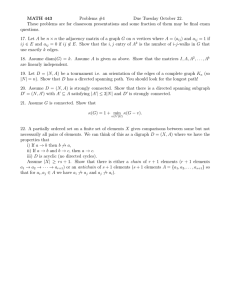
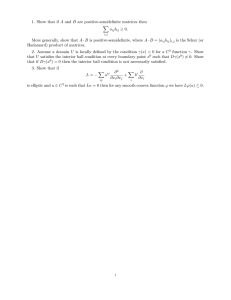
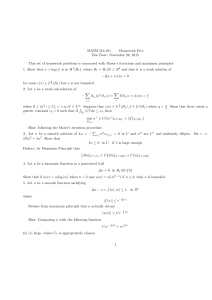
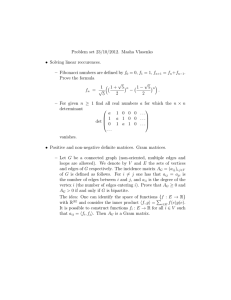
![1. Let R = C[x].](http://s2.studylib.net/store/data/010491179_1-9a9c70e395518f466f652079f02ae14a-300x300.png)
